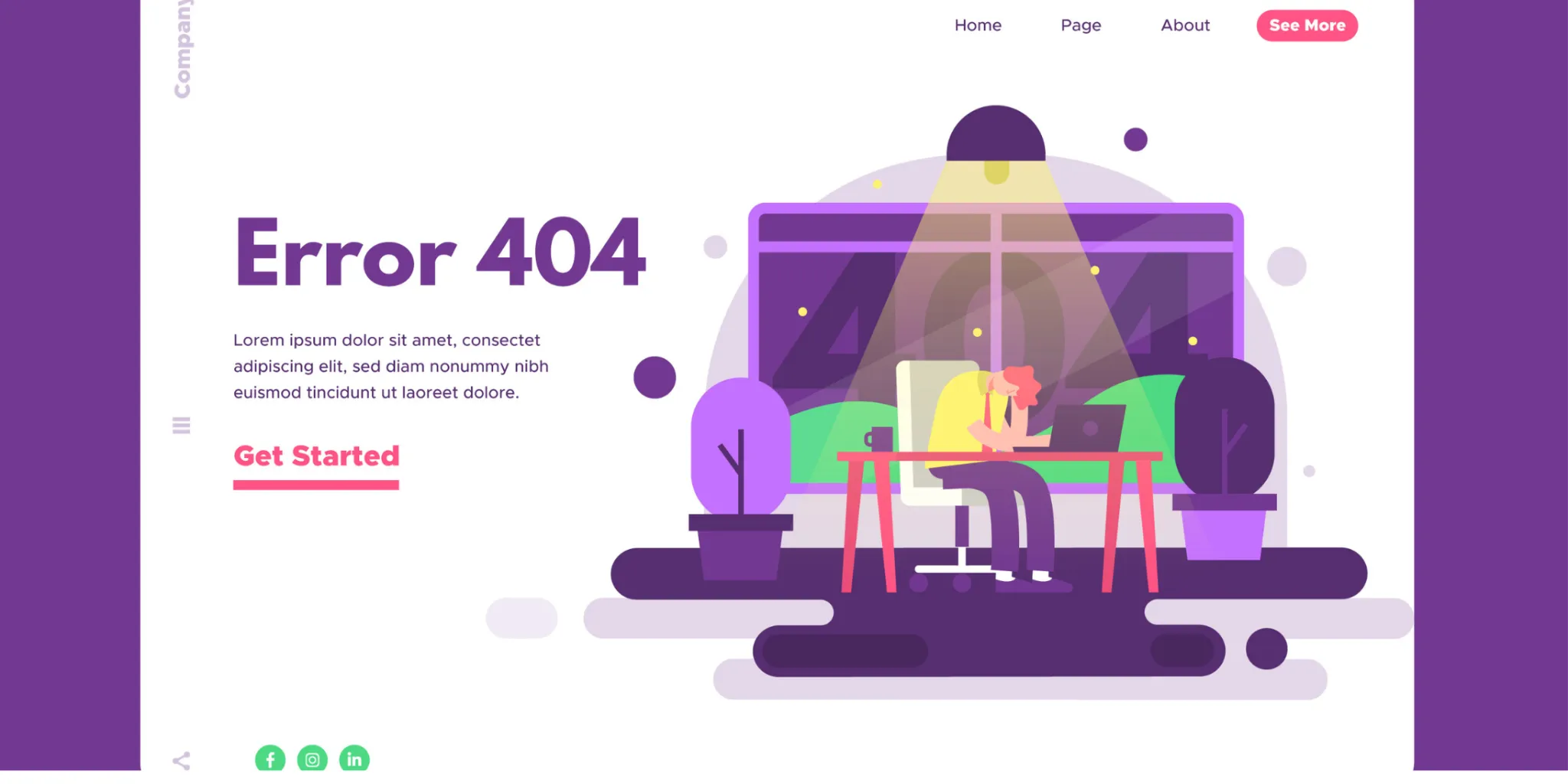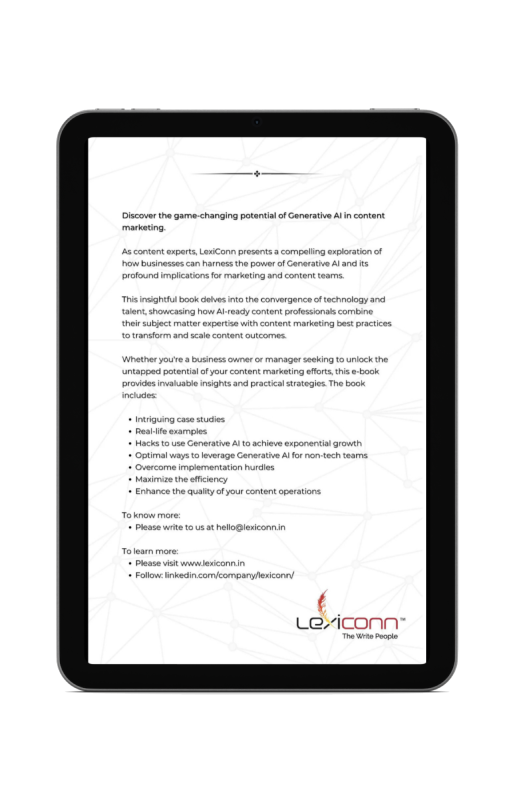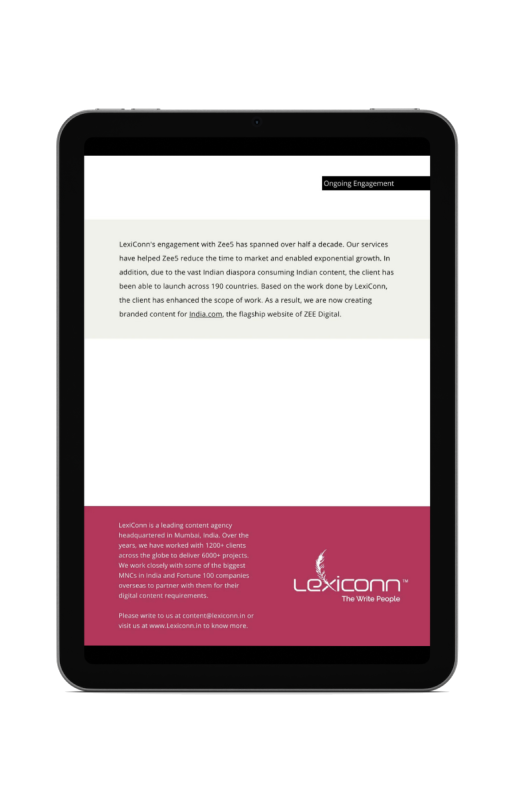
Broken links and poor website navigation are more than just minor annoyances—they can significantly impact your website’s performance, user experience (UX), and search engine rankings. Imagine clicking on a link, only to land on an error page or struggling to find important information because the navigation is cluttered or confusing.

This not only frustrates your visitors but also sends negative signals to search engines, ultimately affecting your SEO.
Fixing broken links and optimizing website navigation are crucial steps in enhancing the user journey. By eliminating errors and streamlining navigation, you make it easier for visitors to access the content they need, which leads to improved engagement, reduced bounce rates, and increased conversions.
At LexiConn, a leading content marketing agency in India, we specialize in addressing website errors and improving site navigation. Our expert team is dedicated to optimizing your website’s performance to ensure a seamless and satisfying user experience.
Let us help you fix broken links and enhance your site's structure for both users and search engines.
When it comes to maintaining a healthy website, broken links, and website errors are serious issues that shouldn’t be overlooked. They affect not only your site's user experience but also its SEO performance and overall credibility. Let’s dive into why these issues matter and how they can harm your website in the long run.
Search engines, like Google, use crawlers to explore and index your website. When a crawler encounters a broken link or a page that doesn’t exist, it can’t properly index that content, which may result in a lower ranking for the affected pages.
This can have a cascading effect, causing your entire website to lose visibility in search engine results. Link equity, or the value passed from one page to another through hyperlinks, also suffers when links are broken, ultimately affecting your SEO performance.
Website errors like 404 pages or broken links are not only frustrating for users but also hinder their ability to navigate your site efficiently. Imagine landing on a page that doesn’t load or clicking on a link that takes you to a dead end. Visitors are more likely to leave your site and seek information elsewhere, leading to increased bounce rates and reduced engagement.
A poor user experience not only affects customer satisfaction but can also damage your brand’s reputation.
In addition to frustrating users, broken links can make your site appear neglected or unprofessional. In today’s competitive online environment, a well-functioning website is essential to building trust with visitors. If users consistently encounter broken links, they might perceive your brand as unreliable or outdated.
This is especially problematic for businesses that rely on their website for conversions, whether it's for lead generation, e-commerce, or other business goals.
When search engines and users can’t access the content they need due to broken links, your site can lose valuable traffic. For businesses relying on organic search to bring in visitors, this can be a huge setback. Without proper link management, you risk losing potential customers, clients, and leads, affecting your bottom line.
Broken outbound links also affect your backlink profile. When an external link leads to a dead page, it not only damages the user experience but also reduces the value of backlinks pointing to your site. This can decrease your site's authority and trustworthiness in the eyes of search engines.
To mitigate the negative effects of broken links, it’s essential to conduct regular website audits. Tools like Google Search Console and Screaming Frog SEO Spider can help identify and fix broken links quickly, ensuring your site stays in top shape. Regular maintenance is key to ensuring a smooth user experience and strong SEO performance.
At LexiConn, we specialize in website audits and fixing broken links to enhance both your site's SEO and UX. Our expert team can help you maintain a high-performing website that keeps visitors engaged and search engines happy.
Identifying and fixing broken links on your website is critical to maintaining user experience and SEO health. Fortunately, several effective methods and tools are available to help you locate and fix these issues easily.
There are several tools available that can help you quickly identify broken links on your site. Some of the most popular options include:
These tools allow you to pinpoint broken links, making it easier to address them in a timely manner.
Broken internal links can cause users to get lost in your site and may harm your SEO by hindering search engines from crawling your pages effectively. Once you’ve identified the broken links, make sure they’re redirected to relevant, active pages or remove them if they’re no longer necessary.
Broken external links, such as links to external resources, can also harm your site’s credibility. Ensure that all outbound links are relevant and lead to reputable websites. If a third-party website goes down or changes URLs, be sure to update those links on your site.
If you’ve removed or changed a page on your website, ensure you set up a 301 redirect from the old URL to the new one. This ensures that visitors who click on old links are automatically redirected to the appropriate page, maintaining a seamless user experience.
Website errors and broken links are inevitable over time, especially as your site evolves. Regular monitoring of your site’s performance ensures that you catch any issues early before they affect your user experience and SEO ranking.
A well-structured link system is vital for both SEO and user navigation. How your links are organized directly impacts how easily visitors can find what they’re looking for and how search engines crawl and index your website. Let’s explore some strategies to improve your link structure for better SEO performance and a smoother user experience.
The text used for internal links plays a crucial role in SEO. Descriptive, relevant anchor text helps search engines understand the content of the linked page. For example, instead of using generic terms like “click here,” use specific terms like “learn more about website navigation best practices.” This not only improves SEO but also provides clarity to users.
Your website’s structure should follow a logical hierarchy, with clear categories and subcategories. A simple, organized structure allows both users and search engines to navigate the site easily. For example:
A clear and hierarchical link structure enhances both the user experience and your site's SEO, as search engines can easily understand the relationships between pages.
Ensure that your most important pages are easily accessible from your homepage or main navigation menu. Important pages should have fewer clicks between them and the user, which makes them easy to find and increases the chances of search engines crawling and indexing them more frequently.
Breadcrumbs are a useful tool for improving both navigation and SEO. They allow users to trace their path back to the homepage, improving usability and giving search engines additional context about your site's structure. For example:
Breadcrumbs are particularly useful for large websites with many pages, offering users a quick way to navigate to higher-level pages and improving overall user satisfaction.
It’s important to regularly review and update your link structure to ensure that everything is functioning properly. Broken or outdated links can frustrate users and negatively impact SEO. Regularly audit your internal and external links to keep your website running smoothly.
At LexiConn, we offer content strategy services to help you design a website that’s both user-friendly and optimized for search engines. Let us help you build a solid link structure that improves navigation and boosts your SEO.
While improving website navigation and link structure is crucial, it's just as important to avoid common mistakes that could hinder your SEO and user experience. Here are some key errors to watch out for:
One of the most common mistakes is making the navigation menu overly complex with too many categories, subcategories, or links. This can overwhelm visitors and make it difficult for them to find what they’re looking for. From an SEO perspective, search engines prefer simpler, clearer structures that are easy to crawl. Stick to the essentials and organize your content in a way that makes sense to your target audience.
With a large portion of web traffic coming from mobile devices, failing to optimize your navigation for mobile is a major mistake. A mobile-friendly navigation menu ensures that users on all devices can easily find their way around your site. Make sure your site is responsive, with a navigation design that adapts to different screen sizes.
Generic navigation labels like “Services” or “About Us” are fine, but they don’t provide enough context. Descriptive labels that include specific keywords can enhance both SEO and user experience. For example, instead of just “Services,” use something more specific like “Content Marketing Services” or “SEO Optimization for Websites.”
Dropdown menus can be helpful but should be used sparingly. When there are too many dropdown options, it can confuse users and create unnecessary complexity. It’s better to keep the navigation simple and consider alternative ways to organize content, such as creating separate pages or categories for different topics.
Failing to use internal links in your content can prevent users from exploring your website further. Internal links not only improve SEO by connecting your pages but also guide users to relevant content, keeping them engaged for longer periods.
By avoiding these common mistakes, you can ensure a more seamless and efficient user navigation experience while boosting your SEO efforts.
Broken links and website errors are more than just inconvenient—they can severely impact your website’s performance, SEO, and overall user experience. Understanding why these issues matter is key to maintaining a healthy and successful website. Here’s why broken links and website errors can hurt your site:

When search engine bots crawl your site and encounter broken links, they can’t index the pages linked to those URLs. This failure to index means that content won’t be visible in search engine results, which directly impacts your rankings.
Moreover, search engines like Google give preference to well-structured, error-free websites. Broken links can cause Google’s crawlers to misinterpret the importance of your content, ultimately lowering your site’s ranking.
A broken link is one of the most frustrating things a visitor can encounter. It disrupts their experience and can lead to increased bounce rates, meaning users leave your site before engaging with it fully. If users find broken links throughout their journey on your site, they are less likely to trust your website and will probably look for information elsewhere.
Repeated broken links and website errors make your website look neglected and unprofessional. For businesses, trust is essential—especially if you’re providing products or services. If visitors come across errors frequently, they may question the reliability of your brand. Maintaining a site free from errors is vital for ensuring that your audience sees you as dependable and trustworthy.
When external websites link to your pages, they pass valuable link equity, which is vital for your site’s ranking. If those links lead to broken pages, you lose this valuable SEO boost. Similarly, internal links that are broken diminish the overall value of your site’s link structure. This can hinder your ability to rank highly in search engine results.
For businesses relying on conversions, broken links can prevent users from completing key actions, whether it's signing up for a newsletter, making a purchase, or contacting you for services. As a result, broken links and website errors can directly affect your bottom line.
By identifying and fixing broken links and website errors, you can restore both the functionality and credibility of your site.
Fixing broken links and optimizing website navigation are fundamental to improving both user experience and SEO performance. By ensuring that your website is free of errors, you not only create a seamless experience for your visitors but also signal to search engines that your site is well-maintained and trustworthy.
From using the right tools to implement smart link structures and avoiding common navigation mistakes, every step you take brings you closer to a better, more efficient website.
At LexiConn, we specialize in providing content strategies and solutions that help you maintain a user-friendly, SEO-optimized site. Our content writing services ensure your website’s content is relevant, engaging, and error-free.
If you want a hands-on approach to improving your website’s performance, book a free consultation or take advantage of our free pilot project to see how we can help. Let us help you enhance your site and boost your business.



I have read and accept the Privacy Policy
Read More